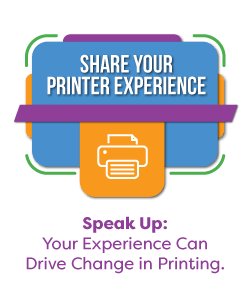Printing Statistics: The Latest Global Data in CMYK
Posted by Rob Errera on 07/06/2022

In today's world, printing technologies are an integral part of the economy – and one of the largest industries.
With the rise of digital products and services, businesses and media outlets have greatly reduced their reliance on print. However, the print industry is still going strong.
From the increased need for commercial packaging, ever-loved paper books, print advertising, on-demand print services, office documents, and the quickly-growing 3D printing industry, print is everywhere you look.
Let’s take a look at the latest printing statistics and discuss the most impactful data, trends, and innovations in the printing industry.
US Printing Industry Statistics
- A statistic from 2019 claims that up to 62% of households in the US own a printer.
- The US printing industry was valued at $77.7 billion in 2021.
- It’s estimated that there are around 46,200 printing businesses in the US. These employ about 350,000 people.
- The industry’s decline is estimated at rates between 1.5% and 2.5% each year. Its decline is faster than the overall industry. The downturn is mainly caused by the spread of digital communication channels. This trend has also decreased the average revenue per employee.

Printing industry is on decline in the US.
- Printing ranks 152nd among the largest manufacturing industries in the US.
- California leads as a state with the highest number of printing businesses – over 2,900. Texas and Florida follow with 1,600 and 1,480 printing businesses respectively.
- 3D is a hot topic – the 3D printing industry was valued at 13.8 billion in 2021.
Check also: Which Industries Print the Most
Printing Statistics around the World
- Printing ranks 14th by market size among manufacturing industries in the world.
- China’s printing industry is huge – and 50% of it is packaging production. Publishing makes up another 30% of the big country’s printing market.
- Globally, 94.3 million printing devices (including printers, copiers, and all-in-one systems) were shipped in 2019.
- Printing gear makes up about 30% of the world’s market for computer peripherals. In particular, inkjet printers make up over 5% of the total computer peripherals market.
Here’s how popular printer brands’ market shares compared in 2021:

- Many of the most popular printer brands come from Japan – including Canon, Brother, Epson, Kyocera, NEC, and Ricoh.
- Prepress services (getting your files ready for printing) is the largest segment of the printing industry, accounting for over 28% of the work.
- 3D printing is on the rise: in 2020, the market value amounted to $13.8 billion – and this trend is expected to grow. More than 2 million 3D printers were shipped worldwide that year.
COVID-19 had an Impact on Print:
- The total US print industry profits decreased by 3.4% in 2020.
- China suffered huge disruptions, which caused an 80% decrease in print production.
- With the sudden shift to remote work, office printing rates decreased dramatically – 13.7%.
- It’s estimated that 2.8 trillion pages got printed in 2020, a lot less than the previous year which had a total of 3.2 trillion pages.
- With the move to the home office, the home printer industry bloomed. In 2020, which was an off-year for print, the global printer market made$42.3 billion in revenue.
- Home-use printer and copier sales flourished in 2020 – with a 12% increase and a total of 107 million units globally.
- In June 2020, one of the leading printer manufacturers Brother reported dramatic increases in laser printer sales. Home-use laser printers became all the rage among people equipping their home offices. In particular, 30% more single-color laser printers, and 42% more color laser printers were sold.

Due to the pandemic there was a boom in home printer sales worldwide.
- The printer industry had a hard time keeping up with the demand. Supply chain disruptions were a big issue during the pandemic, and the manufacturing and delivery logistics of printers, paper, toner, and ink were affected too.
- It’s estimated that the value of out-of-stock items reached $1.14 trillion.
- Print industries around the world are recovering from the far-reaching effects of the pandemic. For example, Mexico’s publishing industry grew by 7.6% in 2021, reaching a worth of US $307 million.
Print vs. Digital Publishing
You might’ve stopped buying large-format daily newspapers, but the print publishing industry is still alive and well. Despite the estimates that e-books will take over the market quickly, paper books remain the most popular reading format.
- In the US, over 74% of people reported reading a book in 2021.
- Among readers, 38% claim they only read in print form, and another 29% say they like both print and digital books,7% of responders read digital formats exclusively.

- 65% of adults in the US read at least one paper book in 2021, 30% picked up an e-reader, and 23% had listened to an audiobook.
- As reported by AAP, these are the major formats among total consumer book sales in January 2022:
| Hardback | 36.3% |
| Paperback | 34.8% |
| Board book | 2.1% |
| E-book | 11.3% |
| Digital Audio | 8.6% |
| Physical Audio | 0.2% |
| Mass market | 2.7% |
- It’s estimated that print formats outsell digital books 4-to-1.
- COVID-19 might have a hand in bringing reading back – between 2019 and 2021, print book sales saw an increase of 21%.
Data on Printing Costs
- On the home printer market, most consumers opt for all-in-one inkjet printers costing less than $400, followed by laser multifunction printers with a starting cost of less than $500. Despite the lower initial cost, inkjet printer ink ends up costing more per page than laser printing.
- An average laser printer toner can put out up to 4,000 pages. That number goes up to 12,000 pages for high-capacity toners.
- It’s estimated that on average, one employee will print out 10,000 pages per year. That adds up to approximately $750 in printing costs per employee.
- The average cost per page for a laser printer is around 5 to 8 cents for black and white and 12 to 15 cents for color, while inkjet printers generally cost about 7.5 cents per page for black and white and 20 cents for color. These costs can vary depending on the printer brand and model.
- Regarding cartridge capacity, high-yield cartridges typically cost less per page than standard cartridges. For example, the standard CF258A (HP 58A) costs about $0.05 per page, but the high-yield CF258X (HP 58X) brings it down to just $0.03 per page. This makes high-yield options a better choice for businesses with high printing demands.
- Another way to save on volume printing is by buying cartridge sets, which often come at a discount compared to individual cartridges. For example, sets like HP 414A 4-Pack and HP 206X Toner 4-Pack can save around $10–$20, while the HP 414X 4-Pack offers savings of up to $70. The HP 650A 4-Pack goes even further, with savings of up to $117.
- While cost-saving is a priority, sustainability is also a key consideration in printing. The US market uses 30% of the world’s paper – that’s over 215 kg a year per person.
- You may worry about the ecological impact of print paper – but rest assured that less than 18% of cut trees are used in the paper industry. In fact, it’s believed that the print industry plays a role in saving forests and preventing deforestation.
The Future is CMYK
The downfall of the printing industry was prophesied decades ago – yet print doesn’t seem to be going away. In fact, it could be said that the industry is going strong.
With the expansion of commercial packaging, more delivery, more on-demand printing, the higher use of home-use and mobile printers, and the public’s undying love for print books, the printing industry is here to stay.
Despite its old age, the printing industry is keeping up with the times too.
Sustainable and eco-friendly printing practices are being introduced every day. LED UV printing is the latest technology that produces fabulous-looking brochures with great efficiency and a lower carbon footprint. Turns out, technological advances won’t kill the printing industry – in fact, they may even help it grow.
Further reading:
- Deforestation Facts and Statistics [Global Data]
- Staggering E-Waste Facts & Statistics
- Eye-Popping Book and Reading Statistics
- The Toner Buzz Guide to Printer Brands and Models
- What Is The Most Popular Color? (It’s not Red)
https://www.ibisworld.com/united-states/market-research-reports/printing-industry
https://www.grandviewresearch.com/industry-analysis/3d-printing-industry-analysis
https://publishers.org/news/aap-january-2022-statshot-report-publishing-industry-up-3-7-for-first-month-of-2022
https://www.statista.com/statistics/541347/worldwide-printer-market-vendor-shares
https://www.statista.com/topics/2991/printers-hardcopy-peripherals









